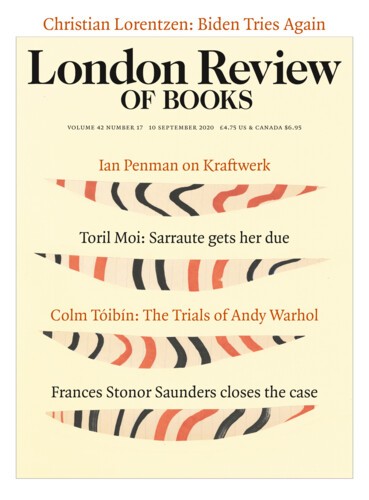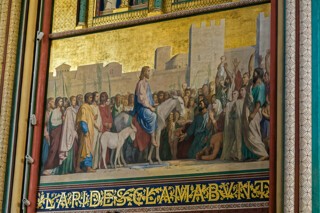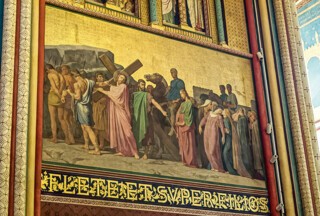Hippolyte Flandrin was the most interesting, and perhaps the most uncompromising, of Ingres’s students. Like Ingres, he worked as a portrait painter, but he devoted most of his career to the painting of murals. There will never be a satisfactory exhibition of his work, but to appreciate his achievements is not difficult since the greatest of these murals are in Parisian churches.
Saint-Vincent-de-Paul, designed by Jacques Ignace Hittorff, is a five-minute walk from the Gare du Nord (also by Hittorff). It was consecrated in 1844 and, because Hittorff was an authority on the use of colour in ancient temples, was intended to have a polychrome interior. In 1849 Flandrin began work on a frieze above the Ionic columns of the nave. He painted a procession of saints: male on the right, with confessors, then bishops, then doctors; mostly female on the left, commencing with ‘saints ménages’ (a category that includes a few husbands), proceeding to penitents, martyred matrons (seven young boys among them) and martyred virgins. Like the architecture to which it is wedded, it unfolds, stanza by stanza.
Little in the way of physical action is represented, though a notable exception is the penitent actress Pelagia, who raises her arms to remove her necklace, her hands outlined by her halo. Facial expression is largely eliminated. Regalia, religious habits and costumes indicative of period or class are simplified to the point where drapery seems almost to replace dress. The lighting is even and the colours are quiet against a background of patterned gold. Every compositional element complements the architecture. Variety in pose and interval, as well as subtle contrasts of characterisation gradually become apparent among the mesmerising, litany-like repetitions. The murals were described by Théophile Gautier as a Christian Panathenaea; they could also be compared to medieval plainchant.
Flandrin’s friezes must influence in subtle ways those for whom they are only background music. For those of us who choose to concentrate on them, the names of more than half of the depicted saints and their classification will be unfamiliar. Both vocabulary and syntax belong to a dead language (though this only sharpens the formal appeal).
Forty years ago, I found the churches of Paris depressingly devoid of real historical echoes, but I have since become increasingly aware of the way each phase of 19th-century history left a trace, often of triumphant denial or defiance. When the 17th-century church of Sainte-Élisabeth-d’Hongrie (not far from the Temple metro stop) was modified in the 1840s, old oak carvings salvaged from the abbey of Saint Vaast were installed in its new ambulatory, and above them a series of murals were painted that owe an obvious debt to Raphael’s first Roman frescoes, particularly the Disputà in the Stanza della Segnatura, which was also admired by the Nazarenes and their Italian counterparts.
This emerging purism had already found a dedicated exponent in Flandrin. His first great success dates from the early 1840s and can be seen in the tribune of Saint-Germain-des-Prés, an ancient church on the Left Bank which had been much battered during the Revolution and was at that time being restored and redecorated. (Polychromy had been enthusiastically adopted by Gothic as well as Greek revivalists in France.) After completing his frieze at Saint-Vincent-de-Paul, Flandrin returned to Saint-Germain to paint in the choir and the nave. All of his work there has recently been cleaned as part of a huge restoration project. The general effect is harmonious – or would be, if we could learn to depend less on electric lighting – and, again, the palette, formal clarity and denial of pictorial space are calculated in relation to the architecture and general colour scheme, even though the serpentine patterns on the walls, largely inspired by illuminated manuscripts, and the spiky Gothic capitals, are less congenial to Flandrin’s figure style than Hittorff’s classical décor.
Flandrin’s Entry into Jerusalem on the north wall of the tribune is in ominous slow motion: Christ in silent profile, the crowd frozen in jubilation behind him, and behind them the implacable geometry of the white city walls. In Christ Carrying the Cross opposite, the drama runs counter to the slow march of figures, taking the form of silent communication between Christ and John, their contact barred by a stern Roman officer, as the Virgin Mary faints. Some of the later narratives in the nave (scenes from the New Testament twinned with the Old) achieve a similar intensity, reducing the action to minimal but memorable formulae, often concealing faces, as when the self-loathing of Judas is concentrated into a hunched back and a clenched fist, or when the Magi prostrate themselves like subject rulers in an Assyrian relief, or when Mary Magdalene is made to seem part of the rock on which the cross is raised.
Delacroix was appalled by this evocation of Giotto and Ravenna. Writing in his journal in 1855 after a visit to the Exposition Universelle, he expressed enthusiasm for British painting – for David Wilkie, Charles Robert Leslie and Francis Grant – and noted that the archaisms of the Pre-Raphaelites (the ‘école sèche’) had not inhibited their response to life and sentiment: he cited the Order of Release by Millais as something beyond the power of ‘nos primitifs, nos byzantins’. Soon afterwards, he began work on his own murals at Saint-Sulpice and moved to the rue de Furstenberg, only a stone’s throw from Saint-Germain-des-Prés, which, we must suppose, he entered with distaste.
Despite Delacroix’s disapproval, Flandrin’s achievement, though always controversial, was much admired, and only began to be ignored fifty years after his death. One way to rescue his reputation would have been to demonstrate the way his murals influenced the flat patterns and pallid harmonies of his fellow Lyonnais artist Puvis de Chavannes, whose work has always been respected because it was of interest to Seurat and even to the young Picasso. But such dubious genealogies (whereby Delacroix himself was the grandfather of both Van Gogh and Matisse) can be discarded now that the 19th century is no longer recent history to be reckoned with and rebelled against. Flandrin’s art was certainly academic, in that it derived from a rigid system of artistic training based on standards which (contrary to the common misunderstanding) had no connection with popular success at the Salon. The more interesting comparison is with Poussin, whose work on occasion he deliberately recalled. Both artists renounced the more seductive and sensational possibilities of painting.
Earlier in the 19th century, ecclesiastical painting had been more dramatic – even theatrical. Also in the church of Sainte-Élisabeth is Merry-Joseph Blondel’s altarpiece, in which the widowed princess Élisabeth, young and pale in white satin, kneels to place her crown at the portal of a Gothic church, dedicating her dowry to the construction of a hospital – much to the alarm of her mother-in-law, who is painted in a brilliant blue velvet cloak. The poor and sick who will receive Élisabeth’s charity lurk in the shadows of the foreground, while on the right her confessor confronts the warriors who will drive her from the castle of Wartburg, which rises in the distance. Completed in 1824 (the year Blondel was made a professor at the École des Beaux-Arts), this is a painting clearly designed for its ecclesiastical location. It even makes allowance for the compositional interruption of the altar cross, and the kneeling saint is placed so as to be clearly visible to all who kneel before her. But in style and stage management it is not very different from the paintings that Blondel made for the Salon, and indeed anticipates by a decade the huge success of Paul Delaroche’s Execution of Lady Jane Gray.
It is a relief to contemplate works of art in a church rather than a museum or a crowded exhibition hall, and especially in Saint-Vincent-de-Paul, a masterpiece of 19th-century architecture, or Saint-Germain-des-Prés, which, though classed as a historic monument, is not a ‘heritage site’. Saint-Germain-des-Prés has had many incarnations since its founding in 543, by King Childebert, as a repository for the relic of Saint Vincent’s tunic. As for the ideals that animated Flandrin’s patrons in an age of revolution and progress, one never knows when they may rise again. Flandrin’s commission was part of a thirty-year project to repair the church after the Revolution, and was championed by Victor Hugo among others. The recent restoration is a major event which has attracted little notice. Attention is instead focused on what is being undertaken at Chartres and at Notre-Dame, which has garnered astonishing donations.
Send Letters To:
The Editor
London Review of Books,
28 Little Russell Street
London, WC1A 2HN
letters@lrb.co.uk
Please include name, address, and a telephone number.



